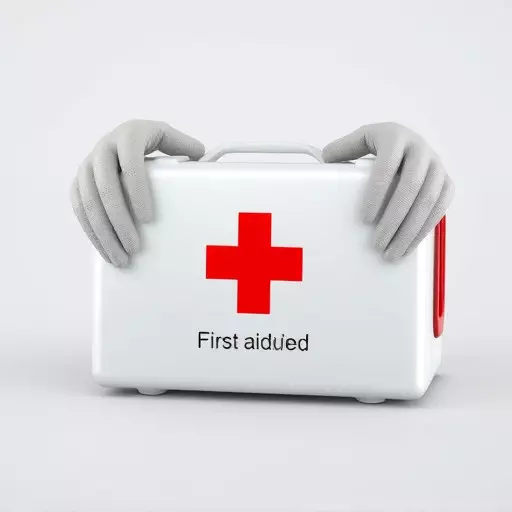Uncontrolled bleeding is a leading cause of injury-related death, highlighting the crucial role of Basic Life Support (BLS) training and first aid certification. These programs equip individuals with knowledge and skills to recognize and manage bleeding emergencies until professional help arrives. Techniques like direct pressure, bandaging, tourniquets, and elevation are essential components of first aid training, enabling life-saving interventions. Prompt action during bleeding emergencies can significantly improve outcomes, making regular BLS and CPR refreshers vital for maintaining preparedness in diverse settings. Adhering to local certification requirements ensures individuals are equipped to respond effectively in critical situations.
Bleeding control is a crucial skill in emergency situations. This comprehensive guide delves into the essentials of first aid for bleeding, covering understanding various causes, immediate actions, and advanced techniques like direct pressure application and hemostatic dressing use. We explore when to seek professional medical help and emphasize the value of Basic Life Support (BLS) and CPR training as complementary skillsets. Additionally, we discuss the importance of staying certified, highlighting key requirements for effective first aid response.
- Understanding Bleeding and Its Causes
- Immediate Actions for Controlling Bleeding
- Applying Direct Pressure: The Cornerstone of First Aid
- Using Hemostatic Dressings and Bandages
- When to Seek Professional Medical Help
- Basic Life Support (BLS) and CPR Training: A Complementary Skillset
- First Aid Certification Requirements: Staying Prepared
Understanding Bleeding and Its Causes
Bleeding is a complex physiological response to injury, involving vasoconstriction (blood vessel narrowing) and coagulation (clotting). Understanding the causes of bleeding is crucial for effective first aid and CPR training. Traumatic injuries, such as cuts, lacerations, or fractures, are common triggers, leading to immediate blood loss. Additionally, internal bleeding can occur due to organ damage or vascular tears, often requiring prompt medical attention. Basic Life Support (BLS) training equips individuals with the knowledge to recognize these situations and administer appropriate first aid until professional help arrives.
The first step in controlling bleeding is to assess the severity. Major bleeding is characterized by rapid blood loss, often visible pulsating arterioles, and signs of shock. First aid certification requirements typically include learning various techniques like applying direct pressure, using pressure bandages or tourniquets (for severe limb bleeding), and elevating the injured area if possible. These skills are vital in managing bleeding and can be life-saving when combined with basic life support training.
Immediate Actions for Controlling Bleeding
In any bleeding emergency, immediate actions are crucial for controlling the flow of blood and preventing further complications. The first step is to assess the situation calmly and identify the source of bleeding. Once located, apply direct pressure using a clean, dry cloth or bandage over the wound. This simple yet effective technique can significantly reduce arterial blood flow and minimize external bleeding.
For more severe cases where bleeding persists, it’s essential to know basic life support (BLS) techniques and first aid certification requirements. Training in BLS and CPR provides individuals with the skills to handle such situations effectively until professional medical help arrives. Remember, prompt action can make a significant difference in managing bleeding control and potentially saving lives.
Applying Direct Pressure: The Cornerstone of First Aid
Direct pressure is a fundamental technique in first aid and CPR training, often considered the cornerstone of bleeding control. When faced with a bleeding injury, applying direct pressure can help stop or significantly reduce blood flow to the affected area. This simple yet powerful method is a key skill for anyone with basic life support training, as it can be the difference between saving a life and allowing bleeding to become life-threatening.
During first aid certification courses, individuals learn the proper techniques for direct pressure, including how to use a sterile or clean dressing to apply firm but gentle pressure on the wound site. By occluding blood vessels and arteries, this pressure helps to stem the flow of blood, reducing the risk of shock and other complications. It’s crucial for first aid practitioners to understand the appropriate amount of pressure to apply, as too much can cause further damage while too little may not be effective in stopping the bleeding.
Using Hemostatic Dressings and Bandages
Hemostatic dressings and bandages are essential tools in any first aid kit and play a crucial role in controlling bleeding during emergencies. These advanced products are designed to enhance basic life support training by providing more effective ways to stop bleeding, especially in external wounds. They work by creating a seal over the injury, forming a barrier against further blood loss.
When applying hemostatic dressings, it’s important to remember the ‘ABCs’ of first aid: Airway, Breathing, and Circulation. Ensure the victim’s airway is clear and they are breathing normally before treating any bleeding. Clean the wound gently, apply the dressing, and secure it with bandages. For severe bleeding, multiple dressings might be required, along with pressure points to stem the flow of blood. Regular first aid and CPR training, along with understanding these techniques, can help individuals respond effectively in critical situations, fulfilling the necessary first aid certification requirements.
When to Seek Professional Medical Help
When it comes to bleeding control, knowing when to seek professional medical help is crucial for effective first aid. While many minor cuts and lacerations can be managed with basic life support (BLS) training and first aid techniques, there are certain situations where immediate professional attention is essential. If the bleeding is severe or does not stop after applying direct pressure for several minutes, it’s time to call emergency services.
Additionally, injuries that involve deep or penetrating wounds, such as those caused by sharp objects or high-velocity impacts, often require advanced medical care. Signs of shock, like rapid breathing, pale skin, or dizziness, should also prompt a trip to the hospital. Always remember that first aid and CPR training can empower you to handle emergencies better, but for complex cases, obtaining proper first aid certification and adhering to local guidelines ensures the best possible outcome for the injured person.
Basic Life Support (BLS) and CPR Training: A Complementary Skillset
Having basic life support (BLS) and CPR training is an invaluable asset in any first aid scenario. These skills provide individuals with the confidence to respond effectively during critical moments, potentially saving lives. BLS training equips people with the knowledge to assess and manage various medical emergencies, including uncontrolled bleeding, which is a leading cause of death from injury. Understanding how to administer CPR not only assists in resuscitation but also supports circulation until professional help arrives.
First aid certification requirements often include both theoretical understanding and practical application of these skills. Training programs teach participants how to recognize the signs of bleeding, its severity, and appropriate interventions. This includes techniques for applying direct pressure, using pressure bandages, and even advanced methods like tourniquets in extreme cases. Combined with CPR training, individuals become well-prepared to handle emergencies, ensuring a crucial complement to their first aid skillset.
First Aid Certification Requirements: Staying Prepared
Maintaining up-to-date first aid and CPR training is essential for anyone looking to fulfill their responsibilities in various settings—from workplaces to public spaces. First aid certification requirements vary by region, but a reputable program typically covers basic life support (BLS) skills, including how to recognize and respond to different types of bleeding. These courses equip individuals with the knowledge and confidence needed to provide immediate assistance in emergencies.
Staying prepared means regularly renewing certifications to stay proficient. Many organizations offer blended or online refreshers that make it convenient to update your skills without disrupting your schedule. By staying current, you ensure that should an emergency arise, you’re ready to act swiftly and effectively, potentially saving a life.


